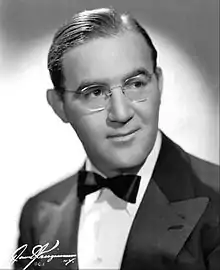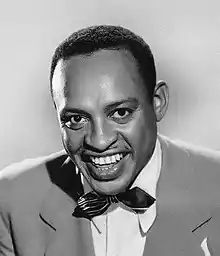List of Harlem Hit Parade number ones of 1944
In 1944, Billboard magazine published a chart ranking the "most popular records in Harlem" under the title of the Harlem Hit Parade. Placings were based on a survey of record stores primarily in the Harlem district of New York City, an area noted for its African American population and regarded as the "black capital of America".[1] The chart is considered to be the start of the lineage of the magazine's multimetric R&B chart,[2] which since 2005 has been published under the title Hot R&B/Hip Hop Songs.
_(LOC)_(4931764613).jpg.webp)
Most of 1944's number ones were in the jazz and swing genres, which were among the most popular styles of music in the early 1940s.[3] Four acts achieved more than one chart-topper during the year: Louis Jordan and his Tympany Five with "Ration Blues" and "G.I. Jive", Duke Ellington and his Famous Orchestra with "Do Nothing till You Hear from Me" and "Main Stem", the Ink Spots and Ella Fitzgerald with "Cow-Cow Boogie (Cuma-Ti-Yi-Yi-Ay)" and "Into Each Life Some Rain Must Fall", and the King Cole Trio with "Straighten Up and Fly Right" and "Gee, Baby, Ain't I Good to You". Jordan's version of "G.I. Jive" was the second recording of the song to top the chart in 1944, following a rendition by Johnny Mercer with Paul Weston and his Orchestra earlier in the year. It was the most successful of many songs released during World War II which bemoaned life in the army.[4] The King Cole Trio had the highest total number of weeks at number one, spending 14 weeks in the top spot; pianist and vocalist Nat King Cole would soon move on from the jazz field to become a hugely successful pop artist.[5]
Two of 1944's Harlem Hit Parade number ones also topped the Most Played Juke Box Folk Records chart, which was first published in the issue of Billboard dated January 8 and covered "Hillbillies, Spirituals, Cowboy Songs, etc";[6] the latter chart is considered to be the start of the lineage of the magazine's country music chart.[7] "Ration Blues" by Louis Jordan and his Tympany Five topped the Harlem chart in the issue of Billboard dated January 1 and the Folk chart eight weeks later. Jordan would go on to be one of the most successful black artists of the 1940s, achieving 18 number ones on the Harlem Hit Parade and its successor charts by 1950, a record which would stand until Aretha Franklin gained her 19th chart-topper in 1985.[8][9] "Straighten Up and Fly Right" by the King Cole Trio topped both listings simultaneously in June.[10]
Chart history
.jpg.webp)
.jpg.webp)


References
- Goldfarb, Michael (February 1, 2011). "Who 'owns' Harlem, the capital of black America?". BBC. Retrieved September 5, 2020.
- Whitburn, Joel (1996). Joel Whitburn's Top R & B Singles, 1942-1995. Record Research Incorporated. p. xii. ISBN 9780898201154.
- "Swing Music Genre Overview". AllMusic. Retrieved September 4, 2020.
- Jones, John Bush (2006). The Songs That Fought the War. University Press of New England. p. 114. ISBN 1584654430.
- Ruhlmann, William. "Nat King Cole Biography & History". AllMusic. Retrieved September 10, 2020.
- "Most Played Juke Box Folk Records". Billboard. January 8, 1944. p. 18. Retrieved March 29, 2018.
- Whitburn, Joel (2005). Joel Whitburn's Top Country Songs: 1944–2005. Record Research. p. ix. ISBN 9780898201659.
- Whitburn, Joel (1988). Joel Whitburn's Top R & B Singles, 1942-1988. Record Research Incorporated. p. 585. ISBN 9780898201154.
- Dahl, Bill. "Louis Jordan Biography & History". AllMusic. Retrieved October 6, 2020.
- Whitburn, Joel (1996). The Billboard Book of Top 40 Country Hits. Watson-Guptill. p. 512. ISBN 0823076326.
- "Music Popularity Chart". Billboard. January 4, 1944. p. 14. Retrieved October 7, 2020.
- "Music Popularity Chart". Billboard. January 8, 1944. p. 17. Retrieved October 7, 2020.
- "Music Popularity Chart". Billboard. January 15, 1944. p. 15. Retrieved October 7, 2020.
- "Music Popularity Chart". Billboard. January 22, 1944. p. 15. Retrieved October 7, 2020.
- "Music Popularity Chart". Billboard. January 29, 1944. p. 15. Retrieved October 7, 2020.
- "Music Popularity Chart". Billboard. February 5, 1944. p. 17. Retrieved October 7, 2020.
- "Music Popularity Chart". Billboard. February 12, 1944. p. 19. Retrieved October 7, 2020.
- "Music Popularity Chart". Billboard. February 19, 1944. p. 15. Retrieved October 7, 2020.
- "Music Popularity Chart". Billboard. February 26, 1944. p. 85. Retrieved October 7, 2020.
- "Music Popularity Chart". Billboard. March 4, 1944. p. 19. Retrieved October 7, 2020.
- "Music Popularity Chart". Billboard. March 11, 1944. p. 17. Retrieved October 7, 2020.
- "Music Popularity Chart". Billboard. March 18, 1944. p. 17. Retrieved October 7, 2020.
- "Music Popularity Chart". Billboard. March 25, 1944. p. 15. Retrieved October 7, 2020.
- "Music Popularity Chart". Billboard. April 1, 1944. p. 15. Retrieved October 7, 2020.
- "Music Popularity Chart". Billboard. April 8, 1944. p. 15. Retrieved October 7, 2020.
- "Music Popularity Chart". Billboard. April 15, 1944. p. 15. Retrieved October 7, 2020.
- "Music Popularity Chart". Billboard. April 22, 1944. p. 15. Retrieved October 7, 2020.
- "Music Popularity Chart". Billboard. April 29, 1944. p. 15. Retrieved October 7, 2020.
- "Music Popularity Chart". Billboard. May 6, 1944. p. 15. Retrieved October 7, 2020.
- "Music Popularity Chart". Billboard. May 13, 1944. p. 15. Retrieved October 7, 2020.
- "Music Popularity Chart". Billboard. May 20, 1944. p. 17. Retrieved October 7, 2020.
- "Music Popularity Chart". Billboard. May 27, 1944. p. 18. Retrieved October 7, 2020.
- "Music Popularity Chart". Billboard. June 3, 1944. p. 15. Retrieved October 7, 2020.
- "Music Popularity Chart". Billboard. June 10, 1944. p. 15. Retrieved October 7, 2020.
- "Music Popularity Chart". Billboard. June 17, 1944. p. 15. Retrieved October 7, 2020.
- "Music Popularity Chart". Billboard. June 24, 1944. p. 17. Retrieved October 7, 2020.
- "Music Popularity Chart". Billboard. July 1, 1944. p. 17. Retrieved October 7, 2020.
- "Music Popularity Chart". Billboard. July 8, 1944. p. 19. Retrieved October 7, 2020.
- "Music Popularity Chart". Billboard. July 15, 1944. p. 15. Retrieved October 7, 2020.
- "Music Popularity Chart". Billboard. July 22, 1944. p. 17. Retrieved October 7, 2020.
- "Music Popularity Chart". Billboard. August 5, 1944. p. 17. Retrieved October 7, 2020.
- "Music Popularity Chart". Billboard. August 12, 1944. p. 17. Retrieved October 7, 2020.
- "Music Popularity Chart". Billboard. August 19, 1944. p. 17. Retrieved October 7, 2020.
- "Music Popularity Chart". Billboard. August 26, 1944. p. 17. Retrieved October 7, 2020.
- "Music Popularity Chart". Billboard. September 2, 1944. p. 15. Retrieved October 7, 2020.
- "Music Popularity Chart". Billboard. September 9, 1944. p. 17. Retrieved October 7, 2020.
- "Music Popularity Chart". Billboard. September 16, 1944. p. 15. Retrieved October 7, 2020.
- "Music Popularity Chart". Billboard. September 23, 1944. p. 23. Retrieved October 7, 2020.
- "Music Popularity Chart". Billboard. September 30, 1944. p. 17. Retrieved October 7, 2020.
- "Music Popularity Chart". Billboard. October 7, 1944. p. 15. Retrieved October 7, 2020.
- "Music Popularity Chart". Billboard. October 14, 1944. p. 15. Retrieved October 7, 2020.
- "Music Popularity Chart". Billboard. October 21, 1944. p. 17. Retrieved October 7, 2020.
- "Music Popularity Chart". Billboard. October 21, 1944. p. 17. Retrieved October 7, 2020.
- "Music Popularity Chart". Billboard. November 4, 1944. p. 17. Retrieved October 7, 2020.
- "Music Popularity Chart". Billboard. November 11, 1944. p. 15. Retrieved October 7, 2020.
- "Music Popularity Chart". Billboard. November 18, 1944. p. 17. Retrieved October 7, 2020.
- "Music Popularity Chart". Billboard. November 25, 1944. p. 17. Retrieved October 7, 2020.
- "Music Popularity Chart". Billboard. December 9, 1944. p. 17. Retrieved October 7, 2020.
- "Music Popularity Chart". Billboard. December 16, 1944. p. 17. Retrieved October 7, 2020.
- "Music Popularity Chart". Billboard. December 23, 1944. p. 17. Retrieved October 7, 2020.
- "Music Popularity Chart". Billboard. December 30, 1944. p. 11. Retrieved October 7, 2020.